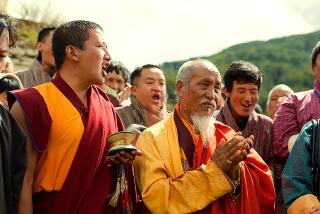On the high road to contentment
New York — Khyentse NORBU would like to introduce his native Bhutan to the world, “before we have 50 Starbucks and McDonalds,” he says. Bhutan is a tiny, lush country in the Himalayas, where the king has decreed that gross national happiness is more important than gross national product. The 44-year-old director, who is polite, thoughtful and has a sly sense of humor and irony, was in New York City recently, talking about his latest feature, “Travellers & Magicians,” which opened in Los Angeles on Friday.
“Until recently Bhutan has been quite secluded and not really open to foreign visitors,” he explains. “But it’s locked between two of the most populous and fast-growing Asian countries, India and China, so it can’t remain like that forever. Already there’s television with 200 channels, and mobile phones.”
“A road film,” Norbu decided, was the best way to present his country. “Transportation is rare in Bhutan -- you always see people waiting for a ride. Sometimes you wait by the side of the road for days. You tell stories, have a good time.”
While “Travellers & Magicians” is the first feature film shot in Bhutan, the director’s purposes were higher than simply creating a visual travelogue. At age 7, Norbu was recognized as the third incarnation of a renowned 19th century nonsectarian saint and scholar. He is addressed as Rinpoche, or Precious One. With that lineage, “Travellers” is bound to carry a message: Appreciate your life, and recognize that life isn’t always better on the other side of the mountain.
Norbu’s main character is Dondup, played by Tshewang Dendup, a reporter for the Bhutan Broadcasting Service and a close friend. (“People ask me why I choose nonactors,” says Norbu. “I have no choice. Bhutan doesn’t have a film industry.”) Dondup is an educated postal official stationed in a remote village, who has a boombox, wears an “I Love New York” T-shirt and sums up village life: “No movies, no restaurants, no cool girls.” America, he believes, is his ticket to happiness, and when a chance to apply for a visa comes along, he hits the road.
While waiting for rides by the side of Bhutan’s one-lane “highway,” Dondup meets several people. A beautiful girl, who has given up her dream of education to care for her elderly father, tempts him to stay in Bhutan. A clever monk tells a story, based on a Buddhist fable, of a young man studying to be a magician, who is carried away by a wild horse to a small hut deep in the forest. There, a bitter old man has all but imprisoned his beautiful young wife, with whom the young magician will fall passionately in love. “Monks are like psychologists in the West,” says Norbu. “They’re advisors, teachers.” Dondup is a reluctant student, creating a tension that holds the narratives together.
Norbu travels easily between East and West; he teaches Buddhist philosophy in the West and returns to Bhutan and India for several months a year. He studied comparative religions in London, becoming enamored of the films of Andrei Tarkovsky, Yasujiro Ozu and Satyajit Ray and worked as a consultant on Bernardo Bertolucci’s “Little Buddha.”
Norbu’s first feature, “The Cup,” about a group of Tibetan monks obsessed with World Cup soccer, was a surprise art house hit. Times critic Kenneth Turan described the film as “charming, slyly comic.... Making the monastery an especially intriguing place is filmmaker Norbu’s genial and unforced feeling for character.”
Alan Kozlowski, the director of photography for this recent film, says Norbu “really feels that the films are tangka paintings for the next generation.” In traditional Buddhist culture, tangka paintings “lead people on journeys of teaching and awareness, with messages encoded in them that liberate and inspire people.”
Languorous mood
Despite carrying “messages,” Norbu’s films are rich and languorous, with spare, nuanced dialogue and solid acting. Sonam Lhamo, 16, who plays the beautiful young traveler in Norbu’s current film, was “discovered” in a card shop in Thimpu, the capital city, and now attends school in New Mexico on a scholarship from the Bhutanese government. She still finds it a little hard to believe she actually got to know Norbu.
“He’s a Rinpoche, he’s really, really holy,” she says. “You expect he’s going to be one of those really holy people who just sit on the throne and chant and bless people. But you can really talk with him about what’s going on and about acting, normal stuff.”
While “making a film in Bhutan is challenging,” says Raymond Steiner, one of the film’s producers -- the crew of 125 endured frigid temperatures at high altitudes -- “working with a Rinpoche proved useful. Local people would recognize him and asked to be blessed, or bring butter tea and good wishes to the crew. Many decisions were made by requesting a mo, a form of divination, and the lama consulted was Orgyen Tobgyal Rinpoche, who starred in “The Cup.”
“O.T. Rinpoche, or One Take we called him,” says Steiner. “O.T. was consulted for the crew, for labs, post facilities, film stock.” As a producer, not being responsible for all the decision-making proved liberating, and people in the U.S. have found the process a good idea. “Can we bring O.T. to L.A. to start a mo agency?” several people have asked.
As a Rinpoche, Norbu may be sanguine about the reception of “Travellers & Magicians,” but as a film director he wonders how his film will be received. “I was surprised by ‘The Cup,’ ” he admits. Part of its success, he believes, is that “it was a bit of a novelty.” Plus, “ ‘The Cup’ had some classic Hollywood grammar: a protagonist, desire, an obstacle to that desire. I made some concessions to Western audiences.”
But with “Travellers & Magicians,” he did not make such concessions. “I’ve always wanted to make a film that doesn’t have classic Hollywood language. They say that the second film is the big challenge, and it’s true.”
*
On the Web
To see scenes from “Travellers & Magicians,” visit calendarlive.com/travellers.
More to Read
Only good movies
Get the Indie Focus newsletter, Mark Olsen's weekly guide to the world of cinema.
You may occasionally receive promotional content from the Los Angeles Times.










